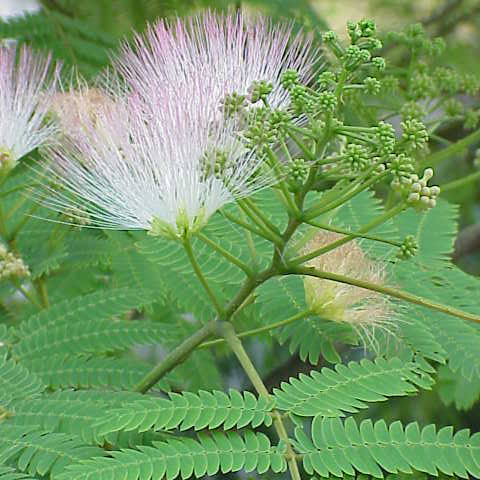Shrubs, trees, or lianas, usually unarmed, the lianas being armed by an unpaired prickle from the base of the leaf-scar. Stipules present, subular to linear or auriculate, often early caducous, in one species transformed into recurved thorns. Leaves bipinnate, not sensitive to the touch, rachis and pinnae with extrafloral nectaries; leaflets opposite, sessile or stalked. Inflorescences consisting of pedunculate glomerules or corymbs which are either axillary or aggregated into terminal or axillary panicles; floral bracts small, linear-oblong, or absent. Flowers pentamerous, usually dimorphic (uniform in 5 species), the marginal flowers in each flowerhead bisexual, the central flower male and enlarged with a conspicuous nectary. Calyx connate, valvate, rarely circumscissile at the base. Corolla connate, valvate. Stamens numerous, united into a tube at the base; anthers eglandular. Ovary solitary, sessile or stipitate. Pods chartaceous to coriaceous, straight (or curved), flat, dehiscent, tardily dehiscent or indehiscent, seeds usually not in separate chambers; valves yellowish, brownish or blackish outside, not reddish inside; endocarp not forming envelopes around each seed. Seeds circular, elliptic to oblong in outline, ± flattened, with a hard testa with pleurogram, wingless; aril absent; endosperm absent; cotyledons large, radicle curved.
Trees or shrubs, mostly unarmed, pubescent or glabrous. Leaves few-ranked, usually large, bipinnate, the pinnae and leaflets few to many pairs; petiole gland-ular, the gland usually borne near or below the middle, less frequently above the middle,-but always below insertion of the lowermost pair of pinnae; petiolar gland concave, longitudinally oblong and sunken in the petiole to orbicular and erect; rachis and pinnular rachis usually also bearing glands, especially towards the tips; leaflets small and linear to moderate and ovate, variously pubescent; stipules usually caducous or lacking. Inflorescence of usually subterminal, axillary, pedunculate heads, spikes, or umbels. Flowers pentamerous, synsepalous and sympetalous, regu-lar, almost invariably perfect, white to pink; calyx campanulate to tubular, toothed apically, usually pubescent; corolla mostly funnelform, valvate; stamens numerous, united below into a staminal tube which is usually included; anthers small, egland-ular. Legume linear to oblong, relatively broad but very flat and thin, straight, dry, not septate, indehiscent or tardily dehiscent, the valves never contorted nor elastically dehiscent, the seeds transverse.
Trees or shrubs, usually unarmed, rarely scandent and with short, recurved hooks. Leaves bipinnate; stipules usually small, rarely larger and caducous; petiole and rachis with glands; leaflets small in numerous pairs or larger in few pairs. Inflorescences of globose heads, arranged in axillary or terminal panicles. Flowers bisexual. Calyx campanulate or funnel-shaped, 5-toothed. Corolla funnel-shaped, upper part 5-lobed. Stamens numerous, connate into a tube at base, free part of filaments long exserted; anthers small. Central flowers of heads with broader calyx and much longer filament tube. Ovary flattened; style long, slender; stigma minute. Legume broadly linear or oblong, straight, plano-compressed, indehiscent, or dehiscent along both sutures, continuous inside. Seeds ovoid or orbicular, compressed, funicle filiform.
Shrubs or trees. Leaves bipinnate; leaf axes with extrafloral nectaries; pinnae 2-6-jugate; leaflets opposite, petiolulate. Inflorescence axillary or a terminal panicle of pedunculate corymbs or glomerules, solitary or fasciculate. Flowers 5-merous, commonly dimorphic with central flower staminate and often larger; calyx and corolla valvate, tubular to funnel-shaped with short lobes. Stamens numerous, united in basal tube; anthers eglandular. Pod flat, chartaceous to coriaceous, dehiscent along both sutures. Seeds circular to oval to oblong, ±flat, unwinged; pleurogram present.
Trees, sometimes shrubs, very rarely climbing (not so in Africa); prickles or spines absent in the African spp. (except for a very small prickle beneath the node in A. harveyi and except that in A. anthelmintica some branchlets may be sharp and spinescent at the ends); sharp hooks apparently representing petiole-bases present in a very few extra-African spp. Leaves 2-pinnate; pinnae each with one to many pairs of leaflets.
Cal campanulate, gamosepalous, 5-toothed; corolla funnelform, gamopetalous, deeply 5-lobed; stamens numerous, long-exserted, the capillary filaments connate below; fr broadly linear, flat, several-seeded; unarmed trees or shrubs with bipinnately compound lvs and pink or white fls in heads. 150, mainly tropical.
Inflorescences of round heads, or (not in native African spp.) spikes or spiciform racemes, pedunculate, axillary and solitary or much more often fascicled, often aggregated near the ends of branchlets which may be lateral and much shortened, sometimes paniculately arranged.
Corolla gamopetalous, infundibuliform or campanulate, with normally 5 lobes (rarely 4 or 6, or in A. coriaria and A. tanganyicensis the lobes may be irregularly connate among themselves).
Flowers hermaphrodite or occasionally male and hermaphrodite; 1-2 central flowers in each head frequently larger, different in form from the others and apparently male.
Stamens numerous (19-50), fertile, their filaments united in their lower part into a slender tube sometimes projecting beyond, sometimes shorter than the corolla.
Pods oblong, straight, flat, dehiscent or not, not septate inside, the valves papery to rigidly coriaceous but not thickened or fleshy.
Calyx gamosepalous, with normally 5 teeth or lobes (rarely 4, 6 or 7).
Seeds usually ± flattened.

